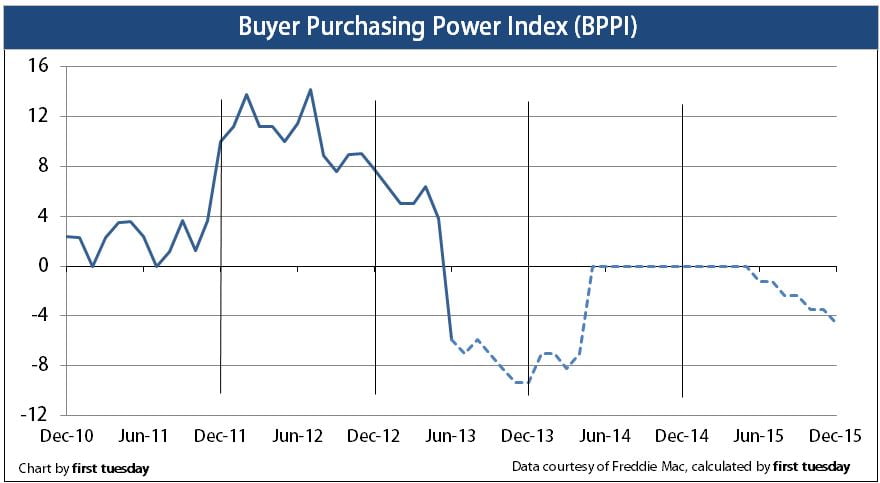The California buyer purchasing power index (BPPI) plunged to -5.91 in June 2013. first tuesday forecasts the BPPI will remain negative through 2014. The BPPI is calculated using the average 30-year fixed rate mortgage (FRM) rate from Freddie Mac (Western region) and the median income in California. A negative index figure translates to a reduced amount of mortgage funds available.
June’s dip represents a 5.91% year-over-year decrease in mortgage funds available to today’s buyers. This is down from 3.77 in May and from 11.45 one year ago.
The sudden drop is due to the recent steep rise in mortgage rates, which have likely reached their peak for this year. Together with a 12-month rise in home prices, buyer purchasing power is down 16% on high price tier homes and 24% on low price tier homes. Conditions are temporarily positive for sellers since the upward home price momentum will persist several months due to buyer expectations. By the end of 2013, pricing will trend flat or down, a result of reduced purchasing power, price increases beyond the rate of inflation and waning market participation by buyer occupants. BPPI will rise from the negative around 2015.
Then, the BPPI will begin a decade’s long period of negative descent as long-term rates rise consistent with steady growth in our dynamic economy. Sellers will continue to experience downward pressure on prices, as buyers will be able to borrow less with the same income.
Chart update 06/28/13
| June 2013 | May 2013 | June 2012 | |
| Buyer purchasing power index (BPPI) | – 5.91 | 3.77 | 11.45 |
About the BPPI
A positive index number means buyers can borrow more money this year than one year earlier.
A negative index figure translates to a reduced amount of mortgage funds available.
An index of zero means there was no year-over-year change in the amount a buyer can borrow. At a BPPI of zero, homebuyers cannot purchase at higher prices than one year before unless they resort to adjustable rate mortgages (ARMs) or greater down payment amounts. To keep the inventory moving at the same pace, sellers will have to lower prices.
As BPPI declines, the capacity of buyers to borrow purchase-assist funds is reduced. In turn, they can only pay a lesser price for a home.
—
first tuesday journal online is a real estate news source. It provides analyses and forecasts for the California real estate market, and has done so since 1978.















Dear Erik:
Thank you for your question. You actually can view the buyer purchasing power index going back to 1992, seen in Chart 1 of the article, Buyer purchasing power determines home prices. The buyer purchasing power index is represented in this chart by the blue bars.
We will look into creating a chart that compares the index with home prices. Thank you for the suggestion!
Regards,
Carrie B. Reyes
Hi Carrie, do you have a chart like this that goes back in time 10-20- years? It would be interesting to plot this against home price changes over the years.
E